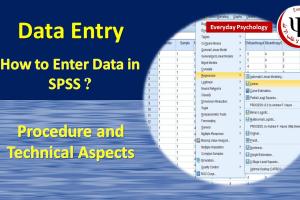Mastering Data Entry in SPSS: A Comprehensive Guide for Beginners

-
Quick Links:
- 1. Introduction to SPSS
- 2. What is SPSS?
- 3. Why Use SPSS for Data Entry?
- 4. Setting Up SPSS for Data Entry
- 5. Data Entry Methods in SPSS
- 6. Step-by-Step Guide to Entering Data in SPSS
- 7. Common Issues in Data Entry and How to Solve Them
- 8. Case Studies and Real-World Applications
- 9. Expert Insights on Data Management in SPSS
- 10. FAQs
1. Introduction to SPSS
Statistical Package for the Social Sciences, or SPSS, is a powerful tool widely used for statistical analysis in social science research. This guide aims to provide you with a comprehensive understanding of how to enter data in SPSS effectively.
2. What is SPSS?
SPSS is a software package developed for interactive or batched statistical analysis. The software offers a range of capabilities, including data management, statistical analysis, and graphical representation.
3. Why Use SPSS for Data Entry?
SPSS is favored by researchers for several reasons:
- User-friendly interface: SPSS provides an intuitive interface that simplifies data entry, even for beginners.
- Comprehensive statistical functions: It supports a wide variety of statistical procedures.
- Data management capabilities: SPSS allows for efficient data manipulation and management.
- Visualization tools: It offers powerful data visualization options to present findings effectively.
4. Setting Up SPSS for Data Entry
Before entering data, you need to set up SPSS correctly. Follow these steps:
- Install SPSS: Download and install the latest version of SPSS from the official IBM website.
- Open SPSS: Launch the software and select 'New Dataset' to start a fresh data entry project.
- Familiarize Yourself with the Interface: Understand the layout, including the Data View and Variable View.
5. Data Entry Methods in SPSS
There are several methods for entering data in SPSS:
- Manual Data Entry: Directly inputting data into SPSS using the Data View.
- Importing Data: Using CSV, Excel, or other formats to import data into SPSS.
- Copy and Paste: Copying data from spreadsheets or other sources and pasting it into SPSS.
6. Step-by-Step Guide to Entering Data in SPSS
Now, let's dive into a detailed, step-by-step process for entering data in SPSS:
Step 1: Define Your Variables
Before entering data, you must define your variables in the Variable View:
- Name: Give each variable a unique name.
- Type: Select the type of data (e.g., string, numeric).
- Width: Set the width of the data.
- Decimals: Define how many decimal places to include.
- Label: Optionally, provide a descriptive label for each variable.
Step 2: Enter Data in Data View
Switch to Data View to begin entering data:
- Click on the cell corresponding to the variable and case.
- Type the data directly into the cell.
- Press Enter to move to the next cell.
Step 3: Save Your Work
Regularly save your dataset to prevent data loss:
- Go to File > Save As.
- Choose a file name and location.
- Select the file format (*.sav).
7. Common Issues in Data Entry and How to Solve Them
Data entry can be prone to various issues. Here are some common problems and solutions:
- Data Type Mismatch: Ensure that the data type in Variable View matches the data you are entering.
- Missing Values: Use the "missing values" option in Variable View to define how you want to handle missing data.
- Data Entry Errors: Always double-check data entries to avoid mistakes.
8. Case Studies and Real-World Applications
To better understand SPSS data entry, let's look at some real-world applications:
- Survey Data Analysis: Researchers often utilize SPSS to analyze survey data efficiently.
- Clinical Trials: SPSS is employed to manage and analyze clinical trial data.
9. Expert Insights on Data Management in SPSS
Experts recommend the following best practices for data management in SPSS:
- Use consistent naming conventions for variables.
- Keep a backup of original datasets to avoid accidental loss.
10. FAQs
What is SPSS used for?
SPSS is used for statistical analysis, data management, and data visualization.
Can I import Excel data into SPSS?
Yes, SPSS allows you to import data from Excel files directly.
How do I save my SPSS project?
You can save your project by clicking on File > Save As and choosing a file format.
What types of data can I enter in SPSS?
You can enter numerical, categorical, and string data in SPSS.
What is the difference between Data View and Variable View?
Data View displays your dataset, while Variable View is where you define your variables.
How do I handle missing data in SPSS?
You can define missing values in the Variable View settings for each variable.
Can I copy and paste data into SPSS?
Yes, you can copy data from spreadsheets and paste it directly into SPSS Data View.
Is SPSS suitable for beginners?
Yes, SPSS provides an intuitive interface that is friendly for beginners.
Are there any online resources to learn SPSS?
Yes, many online platforms offer SPSS tutorials and courses.
How can I visualize data in SPSS?
SPSS offers various options for creating charts and graphs to visualize your data.
Conclusion
Entering data in SPSS can seem daunting at first, but with the right guidance and practice, you can master it. This comprehensive guide has provided you with the necessary steps, tips, and insights to ensure efficient data entry in SPSS.
External References
Random Reads
- How to take screenshot iphone se
- How to unlock ge oven
- How to unlock characters in dont starve
- How to turn on playstation 4
- How to retrieve item flushed toilet
- How to speed up torrents
- How to speed up slow windows computer free
- Why did your discord server disappear
- Unzip files android files google
- Unzip files guide